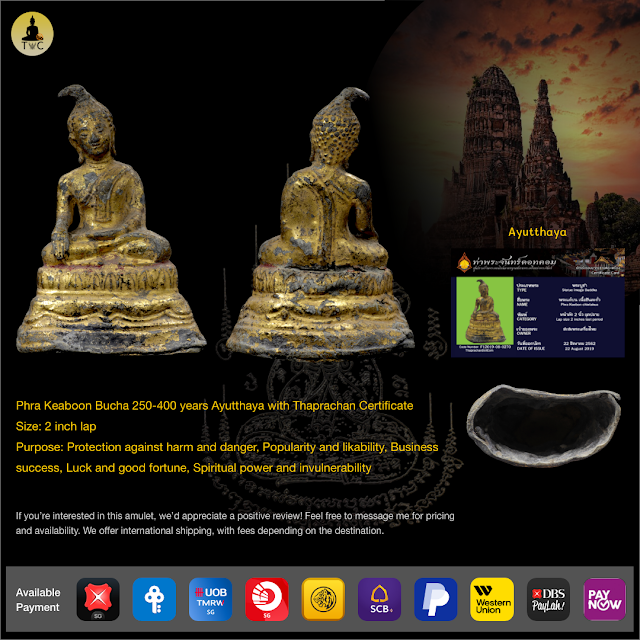Historical Background
-
Name of Artifact: Phra Kaew Boon Bucha (Boonbucha Emerald Buddha)
-
Estimated Age: 250 to 400 years old
-
Period of Origin: Late Ayutthaya Kingdom (approx. 17th–18th century or 1600–1750 AD)
-
Region: Likely crafted and enshrined within central Siam, especially in or around the capital Ayutthaya
This sacred Buddha image, known as “Phra Kaew Boon Bucha,” is widely regarded as a product of the highly artistic and spiritually refined Ayutthaya period. These images served as devotional objects and royal commissions, typically enshrined in temples or noble households.
Artistic Characteristics
-
Material: Typically cast in bronze, copper alloy (samrit), or in rare cases, carved from semi-precious stone. Some may be lacquered and gilded.
-
Craftsmanship Style:
-
Seated in the Maravijaya (subduing Mara) or Dhyana (meditative) posture.
-
Refined facial features with arched eyebrows and a serene expression.
-
Tight curls covering the head and ushnisha (cranial protuberance), with a pointed flame-like finial.
-
-
Base Structure:
-
Double to triple-tiered lotus base.
-
Often inscribed with yantras or religious marks underneath.
-
Spiritual Significance
The Phra Kaew Boon Bucha is not merely a cultural artifact but is deeply revered as a sacred object of worship. It embodies the following qualities:
-
Boon Bucha meaning: “Blessings and Meritorious Reverence”
-
Symbolism:
-
Spiritual protection and blessings to the devotee.
-
Aids in meditation and mental clarity.
-
Symbolizes royal and divine virtues, often associated with wisdom and peace.
-
-
Used in: Household shrines, temple altars, royal merit-making ceremonies.
Cultural and Historical Importance
-
These Buddha images are considered national treasures in Thai culture, representing the zenith of religious art during Ayutthaya.
-
Their creation often coincided with major events—temple dedications, royal birthdays, or spiritual campaigns for unity and peace.
-
Some images are linked to legends or miraculous tales, contributing to their sacred reputation.
Preservation and Authentication
-
Museum Holdings: Many original Ayutthaya-period Buddha images are housed in the Bangkok National Museum, Ayutthaya Historical Study Center, or temple museums.
-
Authentication: Identified by stylistic elements (e.g., robe flow, face shape), alloy content, and sometimes archaeological records or inscriptions.
-
Rarity: Due to age and fragility, original pieces are rare and often valued highly among collectors and historians.
Summary
The Phra Kaew Boon Bucha (Emerald Buddha of Merit and Reverence) is a powerful embodiment of Thai Buddhist heritage, combining the artistry of the Ayutthaya Kingdom with deep spiritual reverence. It remains a lasting legacy of the craftsmanship, religious devotion, and cultural identity of the Thai people from the golden age of Ayutthaya.





